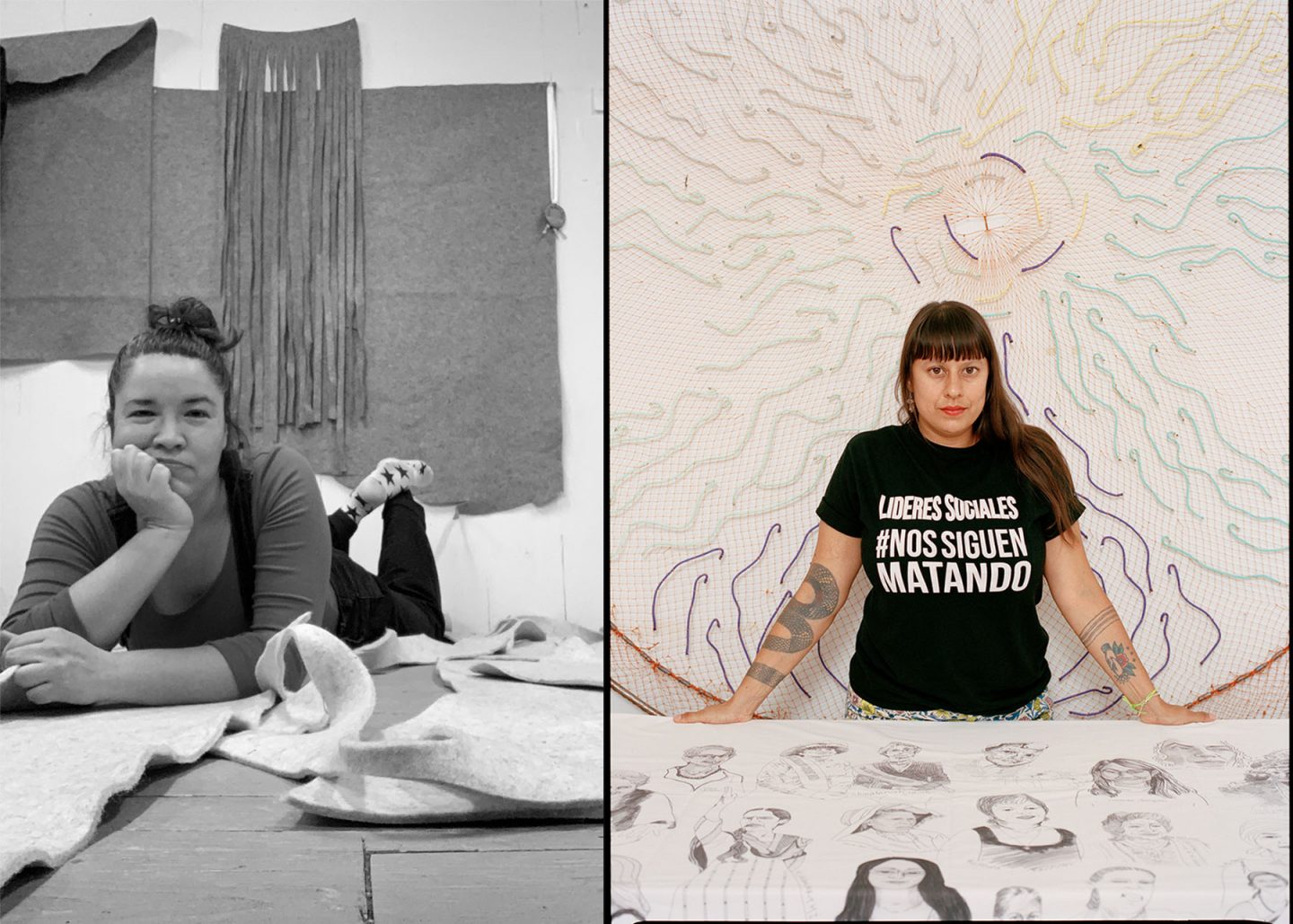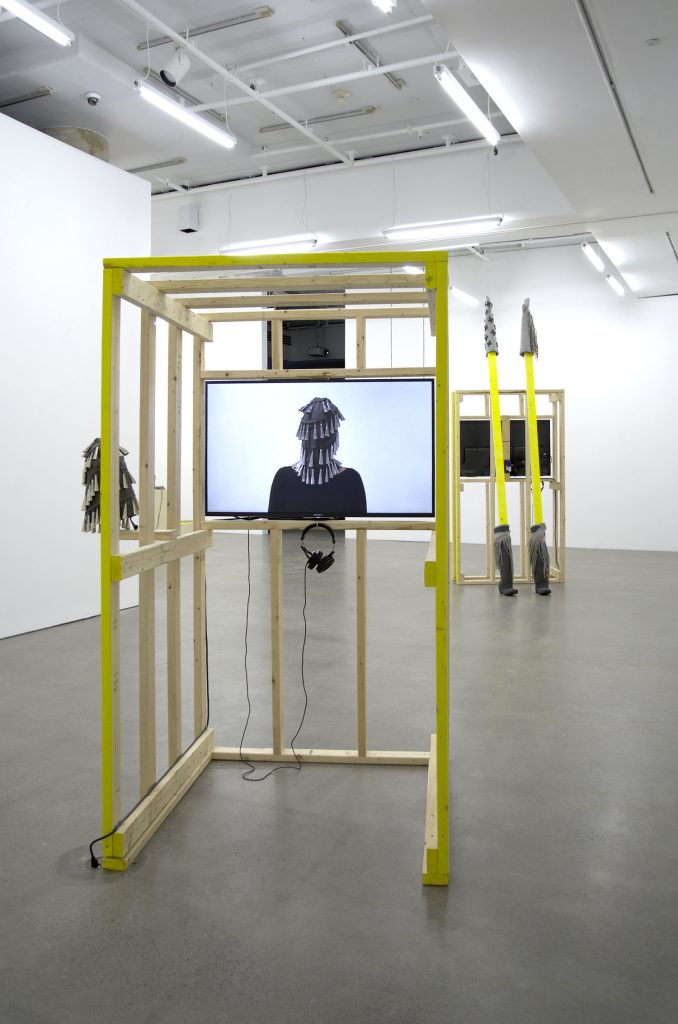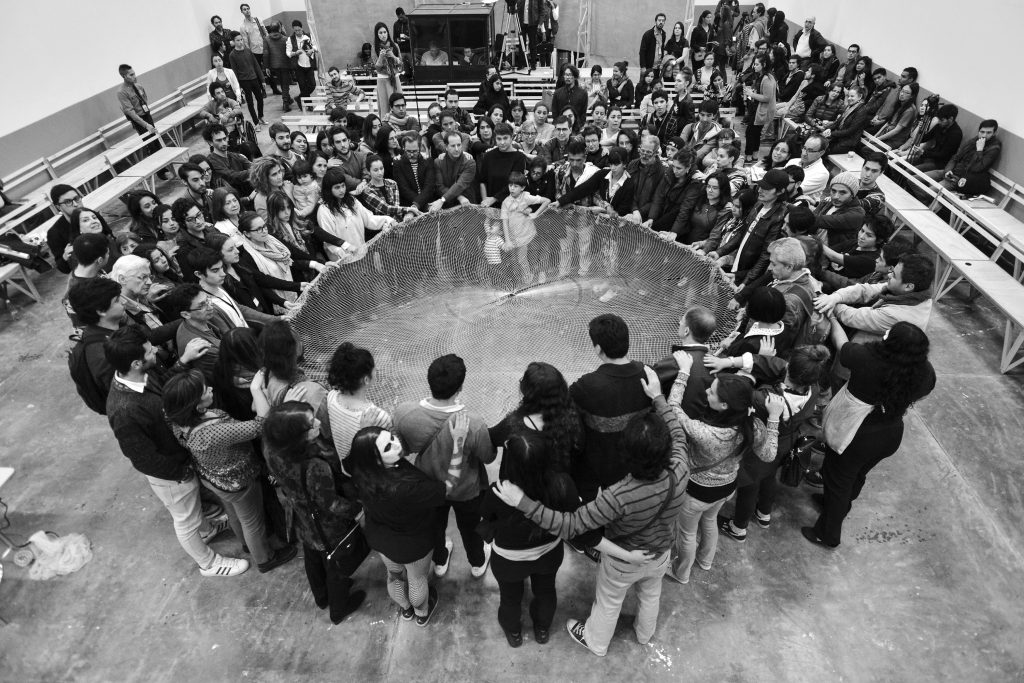
The Vera List Center Expands Support for Indigenous Artists with the Inaugural Borderlands Fellowship
Carolina Caycedo’s acclaimed artworks, which include her “Water Portraits” series, and her “Cosmotarrayas” series of vibrant hanging sculptures made from fishing nets, both inspire and challenge audiences to think of water not simply as a mineral or renewable resource, but as a living entity with a soul. Maria Hupfield’s recent exhibition at the Heard Museum in Phoenix, Arizona, featured the gallery as a site for bodies filled with ongoing live performance art, and a range of pieces made using industrial felt, an approach that strips away essentialist readings to focus on Indigenous art as contemporary, inventive, living, and relevant to the present moment!
Recently, Caycedo and Hupfield were named Borderlands Fellows, a new Fellowship presented in partnership between the Vera List Center for Art and Politics and the Center for Imagination in the Borderlands at Arizona State University. The Fellowship supports research projects that create communities across different geographical, cultural, and political landscapes, and will focus on the relevance of place, thus seeking to explore and apply an Indigenous lens to reflect on the topic of borderlands.
Caycedo, a London-born Colombian multidisciplinary artist known for her performances, video, artist’s books, sculptures, and installations that examine environmental and social issues, will focus her fieldwork and research on Arizona in order to expand the work she’s been doing that explores Westward expansion, and the erasure and displacement of Indigenous knowledge. She will work with Indigenous and other communities impacted by extractivist and borderland infrastructures and with scholars to think through alternative energy models under environmental justice, Indigenous, and ecofeminist frameworks.
Hupfield, an Indigenous off-reservation citizen of Wasauksing First Nation, Ontario, Anishinaabe Nation, is a transdisciplinary artist working in performance and media arts, and since she became a Borderlands Fellow has been hosting private and public conversations with the support of the VLC. She is also pursuing publication of two very different books, including one on Indigenous Performance Art Protocols, and one that will investigate grey felt through image and text.
“The Borderlands Fellowship is one of our most important initiatives in the last few years, probing urgent questions regarding ‘borders’ that are relevant for today’s political and civic realities,” says Carin Kuoni, Director of the VLC. “It is set up precisely to defeat any notion of insurmountable separation of people, communities, and lands, and will support inclusive artistic research projects that thrive on intimate personal relationships but span vast political, cultural, and geographical landscapes.”
The Fellowship grew out of the VLC’s long-standing commitment to programming around Indigeneity and Indigenous art practices, and began to seriously take shape after the two-year initiative in 2016, Indigenous New York, which was led by Kuoni and artist/curator Alan Michelson, Mohawk member of the Six Nations of the Grand River (who joined the VLC’s board of advisors in 2020). This initiative facilitated collaborations and exchanges among Indigenous and non-Indigenous contemporary curators, artists, critics, and scholars through public events and colloquia focused on Indigeneity and the legacy of colonialism, while positioning the local as evidence of concerns shared globally. Natalie Diaz (Mojave, Akimel O’odham), who serves as co-director of the new Fellowship, has been involved with the VLC since 2018 when she appeared in conversation with Hupfield, which helped further the creation of the new initiative.
For both Caycedo and Hupfield, the Fellowship is an affirmation of their individual artistic practices, which are rooted in decolonizing spaces throughout North America, uplifting Indigenous voices and perspectives, and teaching Indigenous knowledge to new communities. As artists, they draw inspiration from a wealth of sources, including the work of activists on the frontlines of environmental justice struggles, other artists engaged in similar practices, and their own communities who have always supported them.
“I don’t consider myself an activist, but as an artist, I do feel very inspired by activists: the people who are literally putting their bodies and their lives on the frontlines of environmental struggle, women precisely,” shares Caycedo. “Feminized bodies, femmes, trans bodies who are on the frontlines inspire me. Their persistence, their clarity, their political sophistication. I’m also inspired by grandmothers, and their capacity to care, to take care, and to embody the knowledge they carry.”
“The current health crisis has forced me to not only examine my process and my relationship to my materials and performance art but also with my body, family, the land where I live,” explains Hupfield. “Currently I am having conversations with other artists, Anishinaabe knowledge keepers, language speakers, and Indigenous academics including my husband Jason Lujan, working with similar research goals but in different disciplines and faculties. These conversations are ongoing and have become my life raft.”
As a Borderlands Fellow, Hupfield plans to expand her existing artistic projects and continue research into the themes she regularly highlights in her work. She is also currently a Canadian Research Chair in Transdisciplinary Indigenous Arts at the University of Toronto, where she started the Indigenous Creation Studio. Hupfield will continue her work of looking at institutions, land, and digital spaces through a decolonial lens, and utilize well published methodological frameworks, processes, and ethical practices based in accountability and apply it to the visual arts, which she recognizes as being “embarrassingly under theorized when it comes to Native makers who are making work on our own land.”
“Through this approach I am able to collapse binaries and hierarchies in the arts such as craft and art, while drawing connections between disciplines like performance art and the performing arts, or with transmediated digital media and say a handmade land-based earth work that are mutually grounded in Indigenous knowledge,” explains Hupfield. “Storywork insists upon the acknowledgement and transfer of embodied knowledge and anti-colonial Indigenous Oral Tradition and Storytelling where beliefs are carried by, enacted through, and worn directly on the body to signal multiple forms of literacy ranging from plant and star literacy across to text, textile, and material literacy, to name a few.”

Ahn, Ahn, Ahn, Kaa, Kaa, Kaa by Maria Hupfield, 2017
Hupfield has titled the work she’s created as a Borderlands Fellow “Breaking Protocol” in order to remind herself to ask who the established protocols serve, and to also create new connections to a rich history of artists such as herself who refuse to conform to dominant narratives.
Caycedo also plans to continue the work she’s been doing prior to becoming a Borderlands Fellow. During the last few years, she has been busy “unlearning Eurocentric givens” and instead been learning and studying Indigenous epistemologies and forming new relationships with Native people who have helped guide her processes and shared their knowledge. She plans to research the extraction of copper in Arizona as part of her Fellowship, and highlight the implications that copper has in technologies of energy transition, including solar and wind.
“I’ve been working with my partner in Texas in the last couple of years to look at how this country was established and how the colonization of the West keeps unfolding into the present through different legal mechanisms,” explains Caycedo. “From surveying, to environmental licenses that grant permission to extract all kinds of minerals, and understanding these economic processes as contemporary colonial forms, I’m interested in how, through my work, I can contribute to the construction of environmental historical memory that allows us to understand that nature is not only a scenario of different violences but is also a victim and a survivor of violences that come precisely through colonial structures, neo-colonial extractivist structures.”

Atarraya by Carolina Caycedo, 2016
Perfomance at ARTBO, International Art Fair Bogota, Photo by Camara de Comercio
As an institution committed to highlighting and expanding the work of Indigenous voices, the Vera List Center for Art and Politics supports the Borderlands Fellows for two years, as they create a research project which comes with an award of $15,000 and curatorial and production support. The Fellows will also take part in a low-intensity residency, where they will spend time together and independently in Tempe, Arizona, and New York City over four semesters. The outcome of their research is financially supported by the two host institutions and artistic explorations will be presented at both sites.
Kuoni is particularly excited that these Fellowships will also recognize and build on significant efforts by faculty at The New School invested in studies of Indigeneity and Decolonization, and is looking forward to collaborations with the Tishman Environment and Design Center and others, including Jaskiran Dhillon, Associate Professor of Global Studies at SPE, who served on the selection committee for the Fellows.
Caycedo and Hupfield are hopeful that their art and research will not only give people the opportunity to gain knowledge about Indigenous communities, but also allow for new connections with Native art to be formed, and stronger, healthier relationships with the natural world to be created.
“I hope people can revise their relationship to what we call the natural world and gain an understanding that these natural environments where we live, that sustain us, are extensions of our body and our relatives, and that we have to care for them,” shares Caycedo. “I also hope that the audience can connect to future and past generations through the work and also be inspired to take further commitments to walk together towards a fair and just energy transition.”
“My hope is that through my projects folks will become curious about my work and value not only my contribution, expertise, and life but by extension, not exception, value all Native Women as makers working from a range of expertise and diverse cultural specificity in the arts,” shares Hupfield. “We are not interchangeable! My dream is that in the Americas folks will see art the way I do as expansive decolonial storywork with each creation opening multiple points of connection and experiences vs. limiting it to narrow definitions that uphold white supremacist colonial and capitalist patriarchal power dynamics.”